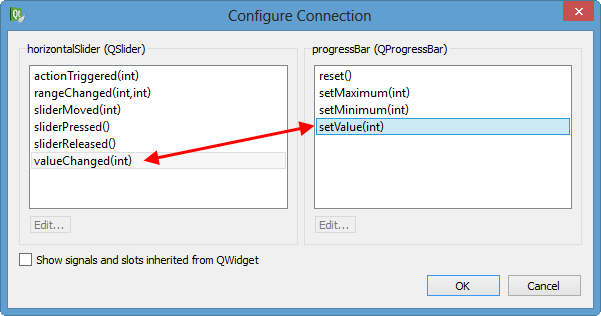Qt Signal Slot Connection Type

./ QMetaObject::Connection Once::connect(const QObject.sender, Signal signal, const QObject.receiver, Slot slot, Qt::ConnectionType type = Qt::AutoConnection) /. Call member function when signal is emitted from sender (in the context of receiver), using the given connection type. Disconnect the slot after N calls, specified by callCount. Connect (button, SIGNAL (clicked ), qApp, SLOT (quit )); Connections can be added or removed at any time during the execution of a Qt application, they can be set up so that they are executed when a signal is emitted or queued for later execution, and they can be made between objects in different threads. There are several ways to connect a signal in Qt 5. Qt 5 continues to support the old string-based syntax for connecting signals and slots defined in a QObject or any class that inherits from QObject (including QWidget) connect( sender, SIGNAL( valueChanged( QString, QString ) ), receiver, SLOT( updateValue( QString ) ) ). If the signal is emitted from the thread in which the receiving object lives, the slot is invoked directly, as with Qt::DirectConnection; otherwise the signal is queued, as with Qt::QueuedConnection. Static Qt.ConnectionType: BlockingQueuedConnection Same as QueuedConnection, except that the current thread blocks until the slot has been delivered. Signal to slot connection: all classes derived from QObject or its subclasses, such as QWidget, can contain signals and slots. It is managed by static method: QObject:: connect (sender, signal (signal), receiver, slot (slot)); where sender and receiver are pointers to objects, and signal and slot are macros for converting signals and slots.
Introduction
Remember old X-Window call-back system? Generally it isn't type safe and flexible. There are many problems with them. Qt offer new event-handling system - signal-slot connections. Imagine alarm clock. When alarm is ringing, signal is sending (emitting). And you're handling it as a slot.


- Every QObject class may have as many signals of slots as you want.
- You can emit signal only from that class, where signal is.
- You can connect signal with another signal (make chains of signals);
- Every signal and slot can have unlimited count of connections with other.
- ATTENTION! You can't set default value in slot attributes. e.g.
void mySlot(int i = 0);
Connection
You can connect signal with this template:QObject::connect ( const QObject * sender, const char * signal, const QObject * receiver, const char * method);You have to wrap const char * signal and const char * method into SIGNAL () and SLOT() macros.
And you also can disconnect signal-slot:QObject::disconnect ( const QObject * sender, const char * signal, const QObject * receiver, const char * method);
Deeper
Widgets emit signals when events occur. For example, a button will emit a 'clicked' signal when it is clicked. A developer can choose to connect to a signal by creating a function (a 'slot') and calling the connect() function to relate the signal to the slot. Qt's signals and slots mechanism does not require classes to have knowledge of each other, which makes it much easier to develop highly reusable classes. Since signals and slots are type-safe, type errors are reported as warnings and do not cause crashes to occur.
For example, if a Quit button's clicked() signal is connected to the application's quit() slot, a user's click on Quit makes the application terminate. In code, this is written as
connect(button, SIGNAL (clicked()), qApp, SLOT (quit()));
Connections can be added or removed at any time during the execution of a Qt application, they can be set up so that they are executed when a signal is emitted or queued for later execution, and they can be made between objects in different threads.
Qt Signal Slot Connection Type

Qt Signal Slot Connection Types
The signals and slots mechanism is implemented in standard C++. The implementation uses the C++ preprocessor and moc, the Meta-Object Compiler, included with Qt. Code generation is performed automatically by Qt's build system. Developers never have to edit or even look at the generated code.